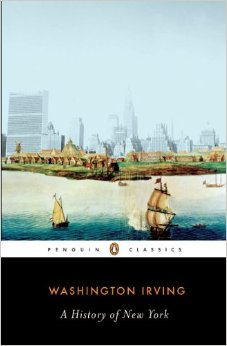New York is an iconic city, ever hip and ever changing, with an accompanying literature that expresses its grit and glamour. Lists of iconic New York novels abound, compiled because they depict the marrow of the metropolis in a particular swath of time. Writers contributing to a New York literature are many and various: they include Melville, James, and Wharton in the nineteenth century and Fitzgerald, Baldwin, and McCarthy in the twentieth. You can compile your own list for the twenty-first. We’re only fifteen years in, but you will still have too many choices for writers that spin New York City as a central character. But where did it all begin?
Washington Irving’s A History of New York from the Beginning of the World to the End of the Dutch Dynasty is not exactly a novel, but it is a fun read no matter how you characterize it. There were no American novels back then. We’re talkin’ 1809. A History of New York introduced the world to its ridiculous but perspicacious narrator, Diedrich Knickerbocker, a fusty Dutchman, who in 1804 elaborated on a delectable walk along the Battery and came to be a moniker for all things related to the burgeoning city and its inhabitants for over two hundred years, including its current basketball team. Who cares if Jon Stewart is leaving The Daily Show when you can read great political satire by the very first New York writer?
Irving had a unique perspective on the absurdities of pre- and post-revolutionary politics at the dawn of the new nation. He irreverently skewered the founding fathers and all their puffed-up rhetoric. Irving always inserted an absurdist narrator between himself and the reader, the same kind of trick that Stephen Colbert employed for years from behind his desk. He invented a historian with attitude, who relentlessly mocked the literary and scholarly professions as well as poking fun at himself. He created a persona that both delivers the content and is the content and went to great lengths to convince readers that his character was an actual person. In a move that would make any modern marketing director proud, he concocted a story that Knickerbocker had gone missing, and then placed ‘missing person’ notices in newspapers. Sales went through the roof.
Knickerbocker was the quintessential New York writer: he resided in overpriced and seedy housing, quarreled with his landlord and got lost in its streets. He was America’s first unreliable narrator. Here’s Diedrich Knickerbocker on the scholarship of history:
Thus it would seem that knowledge and genius, of which we make great parade, consist but in detecting the errors and absurdities of those who have gone before, and devising new errors and absurdities to be detected by those who come after us.
He included himself in the mockery:
I generally make it a rule, not to examine the annals of the times whereof I treat, further than exactly a page in advance of my own work; hence I am equally interested in the progress of my history, with him who reads it, and equally unconscious, what occurrence is next to happen.
The City of New York endures as a literary capital, and Irving was born there the same year the American Revolution ended. Today, his political satire is largely unfamiliar to most Americans and many New Yorkers have forgotten who their basketball team is named after. Indeed, he is perhaps better known as the author of “The Legend of Sleepy Hollow,” which depicts the renowned headless horseman. While he is thought of as the first American writer, he, ironically, spent more than twenty years of his life living abroad in Spain and England and his most famous folktale, “Rip Van Winkle,” now considered to be archetypally American, is adapted from a European one. Certainly Rip’s story, which is a tale of fame gained by idle insouciance and social befuddlement, elevates the wild and inconvenient imagination lest it be defeated by American provincialism or puritanism. What could be more New York than that?
Christine Wade is the author of the novel Seven Locks.





